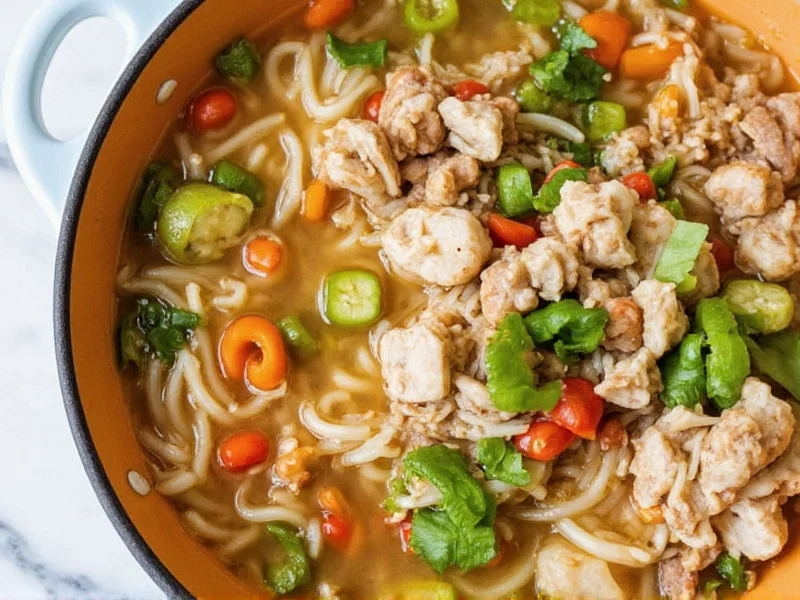Understanding the calorie content of pho soup requires examining multiple factors that influence its nutritional profile. While the base range sits at 350-450 calories for a standard serving, various elements can significantly increase or decrease this count.
Factors That Affect Pho Soup Calorie Count
Pho's calorie content isn't fixed—it varies based on several key components. Being aware of these variables helps you make informed choices whether dining out or preparing pho at home.
Broth Type and Preparation
The foundation of pho, the broth, contributes differently to calorie counts depending on preparation:
- Traditional clear beef broth: 60-100 calories per serving (varies with fat content)
- Creamy or bone marrow-enriched broths: Can add 100+ additional calories
- Homemade vs. restaurant broths: Commercial versions often contain more sodium and hidden fats
Protein Selection Matters Most
The meat component creates the largest calorie variations in pho soup:
- Lean beef (flank, eye of round): 120-150 calories per 3-ounce serving
- Fattier cuts (brisket, fatty beef): 200-250 calories per 3-ounce serving
- Chicken pho (breast meat): Typically 100-130 calories for equivalent portion
- Meatballs or processed meats: Can add 50-100 extra calories
Rice Noodles Quantity
Noodles constitute a substantial portion of pho's calories:
- Standard portion (4-5 oz cooked): 150-180 calories
- Double noodle portions: Can reach 300+ calories
- Noodle thickness variations: Thicker noodles contain more carbohydrates
| Pho Variation | Calorie Range | Protein (g) | Carbs (g) | Fat (g) |
|---|---|---|---|---|
| Traditional Beef Pho (standard) | 350-450 | 20-25 | 45-55 | 8-12 |
| Chicken Pho | 300-400 | 22-28 | 40-50 | 6-10 |
| Pho with Fatty Beef Cuts | 450-600 | 25-30 | 45-55 | 15-25 |
| Vegetable Pho (broth-based) | 250-350 | 5-10 | 50-60 | 3-7 |
| Pho with Extra Noodles | 500-650 | 20-25 | 65-80 | 8-12 |
Nutritional Considerations Beyond Calories
When evaluating pho soup nutrition facts, calories tell only part of the story. Several other nutritional elements impact its healthfulness:
Sodium Content
Restaurant pho often contains 1,500-2,500mg of sodium per bowl—up to 100% of the recommended daily limit. Homemade versions allow for sodium control, potentially reducing this by 30-50%.
Protein Quality
Pho provides high-quality protein from meat sources, typically delivering 20-30 grams per serving. This makes it more nutritionally balanced than many other restaurant noodle dishes that prioritize carbohydrates over protein.
Vegetable Content
Traditional pho includes minimal vegetables in the broth, but the standard side plate of bean sprouts, basil, and lime adds fiber and nutrients with negligible calories (approximately 25-30 calories total).
Pho in a Balanced Diet
Is pho soup healthy for weight loss? The answer depends on preparation and portion control. Compared to many restaurant meals, standard pho offers:
- Better protein-to-carbohydrate ratio than most noodle dishes
- Naturally low in saturated fat when prepared with lean meats
- Hydrating properties from the broth base
- Opportunities for customization to fit dietary goals
Smart Ordering Strategies
When dining out, use these techniques to manage pho noodle soup calorie intake:
- Request "less noodles, more meat" to increase protein and reduce carbs
- Choose chicken pho over beef for slightly lower calorie options
- Avoid fatty beef cuts like brisket if watching calorie intake
- Limit additional condiments which can add 50-100 calories
- Share a bowl with someone to control portion size
Homemade Pho Nutrition Facts
Preparing pho at home gives you complete control over calorie content. Key strategies include:
- Skimming fat from broth during preparation
- Using lean meat cuts and precise portions
- Measuring noodle portions (3-4 oz dry weight per serving)
- Adding extra vegetables to the broth for flavor without calories
- Using low-sodium fish sauce alternatives
A carefully prepared homemade pho can stay within 300-350 calories while maintaining authentic flavor.
Comparing Pho to Other Restaurant Meals
When evaluating pho soup calorie count against alternatives:
- Typical pho (350-450 calories) vs. Pad Thai (900-1,200 calories)
- Pho vs. Ramen: Traditional ramen often contains 500-800 calories with higher fat content
- Pho vs. Fried Rice: Standard fried rice dishes typically exceed 700 calories
- Pho provides more balanced nutrition than many comparable noodle dishes











 浙公网安备
33010002000092号
浙公网安备
33010002000092号 浙B2-20120091-4
浙B2-20120091-4